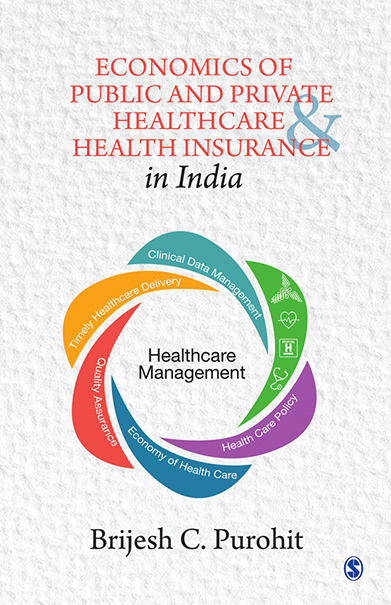
Brijesh C. Purohit is currently a Professor at Madras School of Economics, Chennai, India. After completing his PhD in Economics from Institute for Social and Economic Change, Bangalore he has gathered nearly 25 years of professional experience which includes teaching, training, research and consultancy. He has served at various reputed institutions in India at different points of time and was a South Asian Visiting scholar at Queen Elizabeth House, University of Oxford, UK. He has published a number of books and articles in reputed national and international journals. His research and teaching interests include health economics and financing, public economics and insurance.
Economics of Public and Private Healthcare and Health Insurance in India, First Edition by Brijesh C. Purohit, Professor at Madras School of Economics, Chennai, India (SAGE India, 2020, Hardcover. ISBN: 9789353287955) – https://in.sagepub.com/en-in

Covid 19 has led to a large number of casualties, widespread suffering and disruption of all economic activities. Till July 25, 2020, globally there are 15,945,330 cases, and at the national level India recorded 1,336, 861 cases. Overall total number of deaths has reached a figure of 642,776 with 5,559,675 active cases after recovery and deaths. In India casualities are 31,358 with 456,071 active cases remaining.
Besides disruption of various sectors’ output, employment and labour force, it has put a strong pressure on both public and private sectors’ healthcare facilities. A new requirement for separate quarantine hospitals / facilities has emerged. Also to overcome the plight of doctors and paramedics (or our Corona warriors), there is a fresh thinking to adopt measures in health facilities to prevent this health manpower from falling prey to Corona infections and consequent fatalities. The fear and phobia of private sector hospitals to refuse to admit Corona infected patients has been highlighted in the media time and again. Thus rising costs and falling incomes owing to a considerable expenditure on the preventive measures, private sector hospital facilities have faced a financial crunch and public sector hospitals are under tremendous pressure to overload their medicals/ paramedical staff. This has led to all out diversion away from non- communicable diseases and other hospital services to prioritize Corona patients. According to an estimate, short term operating losses are likely to be INR 140,000 to 240,000 for a quarter and revenues to private sector hospitals is likely to be lower by 20-35 percent in fiscal year 2021 in contrast to comparable figures of preceding fiscal year[1]. According to some other estimates, a liquidity infusion of INR 16,000 crores (16 billion) to 22,000 crores (22 billion) will be required by the private healthcare sector in India[2].
Globally, World Health Organisation (WHO) reminded us by its reports that it could be a $9 trillion impact on global economy. Also it is pertinent to point out that in comparison to earlier global pandemics including SARS (in 2003), H5N1 (in 2006), H1N1 (in 2009), Ebola (in 2013) and MERS (in 2015), the financial impact distortion due to Corona is potentially threatening a worldwide recession. A WHO survey across 115 countries indicates that Corona pandemic globally has disrupted in more than 53% of the countries hypertension treatment, in 49% diabetes treatment and related complications, in 42% cancer treatment and in 31% for cardiovascular emergencies.[3] Many countries (around 58% and 42% low income countries) are now experimenting with other innovative methods of treatment including tele-medicines to deal with non-communicable diseases. These diseases are also responsible to kill 41 million people each year and 71 % of the deaths globally[4].
To overcome the current pandemic crisis, the measures adopted by the Indian government have been swift and successful in preventing number of deaths relative to its large population and in contrast with many other countries. According to a survey called “Oxford Covid 19 government tracker” covering 73 countries including India, our nation has scored cent percent scores. The government responses included screening and tracking of the Indian and foreign national travellers to India, quarantine for them and further followed by tracking their conditions and health progress. This was further followed by suspension of all travelling –domestic and international- on March 20 and complete lockdown on March 22 for three weeks and other phases of lockdowns (four phases) with some discretion left to Indian States to allow functioning of some transport and business activities in Covid 19 free zones. Yet we should not forget that our administrative measures would have been more successful to prevent spread of Covid 19, if we had a stronger public healthcare sector supported by private healthcare, as well as a better hospitals network, which might have led to a less catastrophic financial situation for Covid 19 infected cases. Further this support in corona times would have been enhanced with the presence of a stronger healthcare insurance mechanism.
At present India ranks 145 among 195 countries in terms of quality and accessibility of healthcare services. This is largely attributable to low government expenditure which is just 1.5 percent of GDP. Indeed, Indian government is planning to increase its expenditure to be around 2.5 percent of GDP in near future. Some steps in this direction are seen through expansion of public sector facilities like advanced tertiary care facilities and increase in number of ayurvedic educational institutions. Yet main funding for real patient care like increasing availability of medicines, material and manpower is lacking at primary and secondary government facilities[5]. Notable however, is a recent increase in public private partnership facilitated by many government sponsored health insurance schemes either at the national or state level. At the national level, for instance, we have, which among others include, Ayushman Bharat Pradhan Mantri Jan Arogya Yojana (initially called only Ayushman Bharat and later renamed (AB PM-JAY), ESIS (employees state insurance scheme), CGHS (Central Government Health Scheme), RSBY (Rashtriya Swasthya Bima Yojana). Out of these plans, ESIS and CGHS are based on certain basic requirements (of occupation and income) and there is no choice for others not satisfying the basic eligibility to above two categories which are predefined by the occupation either in central government or in factory sector with certain income slab. Besides, we also have as many as 17 state sponsored schemes. In the near future, many of the state sponsored schemes might merge with PMJAY. From March 24 2020, the National Health Authority (NHA) has decided to cover Covid-19 treatment of the poorest of the poor in private hospitals under Ayushman Bharat — the central government’s health insurance scheme for the deprived. An Ayushman Bharat beneficiary would be able to get himself tested for Covid-19 in any empanelled private hospital free of cost as per the NHA’s decision. In case a suspected Covid-19 patient has to be isolated in a private hospital, the isolation would also be covered under the scheme[6].
Since the basis of these schemes is mediclaim mechanism in which cashless treatment to patient is done and the private insurance company manages care through empanelled private hospitals with expenditure reimbursed through the funding from central and state government which is 80-20 percent ratio. This indeed is a part of increasing public expenditure through insurance which has an intrinsic element of public private partnership partially taking care of inadequacy of public hospital network[7]. Thus in Corana period as far as expenditure to poor is concerned for Covid 19 treatment is taken care through national and other state sponsored scheme. Yet prevention is better than cure as old dictum says, the role of social distancing now emphasised by government lockdowns and follow up legislation is quite significant to check rapid spread of corona infections as well as help in avoiding the consequent misery of the infected.
 At the moment three types of governmental measures are desirable. These may include short term measures like increasing public expenditure to take care of extra load on public hospitals in terms of large diversion of medicines, materials and equipments which is at the cost of these resources away from other types of patient care. Partly the recent relief measure by the central government has done it to help frontline workers only. Under the package the government proposes to provide an insurance cover of INR 5,000,000 per person to frontline health workers-sanitation staff, paramedics and nurses, ASHA workers and doctors who are working to tackle Covid 19 illness and face the highest risk. This cover will be for three months with effect from March 25, 2020 and benefit nearly 2.2 million health workers[8]. However, this expenditure is only rerouting of public health expenditure. More needs to be done to provide care in the short run also by increasing medical supplies to public sector hospitals. Also fear psychosis of common man of catching corona infections in these hospitals need to be tackled by increasing preventive measures at these hospitals. In the medium term more equipments and additional staff and infrastructure should be taken care of by additional funding. Finally, in the long run additional medical expert cell and separate chain of hospitals should be planned to control excessive impact of such kind of pandemics.
At the moment three types of governmental measures are desirable. These may include short term measures like increasing public expenditure to take care of extra load on public hospitals in terms of large diversion of medicines, materials and equipments which is at the cost of these resources away from other types of patient care. Partly the recent relief measure by the central government has done it to help frontline workers only. Under the package the government proposes to provide an insurance cover of INR 5,000,000 per person to frontline health workers-sanitation staff, paramedics and nurses, ASHA workers and doctors who are working to tackle Covid 19 illness and face the highest risk. This cover will be for three months with effect from March 25, 2020 and benefit nearly 2.2 million health workers[8]. However, this expenditure is only rerouting of public health expenditure. More needs to be done to provide care in the short run also by increasing medical supplies to public sector hospitals. Also fear psychosis of common man of catching corona infections in these hospitals need to be tackled by increasing preventive measures at these hospitals. In the medium term more equipments and additional staff and infrastructure should be taken care of by additional funding. Finally, in the long run additional medical expert cell and separate chain of hospitals should be planned to control excessive impact of such kind of pandemics.
[1] EY- FICCI (2020) “Covid 19 impact assessment for private healthcare sector and key financial recommendation measures for the sector”
[2] Vishal Bali(2020) “How healthcare sector can navigate Covid 19 storm”, Healthcare Radius, April 30.
[3] WHO (2020), Covid 19 significantly impacts health services for non-communicable disease”, June 1.
[4] Kaivaan Movdawalla (2020), “Covid 19-Impact assessment for private healthcare sector and key recommendations on financial measures required for the sector”, April 13.
[5] See, a recent work Purohit Brijesh C. (2020), Economics of Public and Private Healthcare and Health Insurance in India, Sage publications.
[6] See::https://economictimes.indiatimes.com/news/politics-and-nation/covid-19-treatment-to-be-covered-under-ayushmanbharat/articleshow/74784764.cms?utm_source=contentofinterest&utm_medium=text&utm_campaign=cppst
[7] Purohit (2020) , op.cit.
[8] See, Economic Times, May 25, 2020
© Dr Brijesh C Purohit


